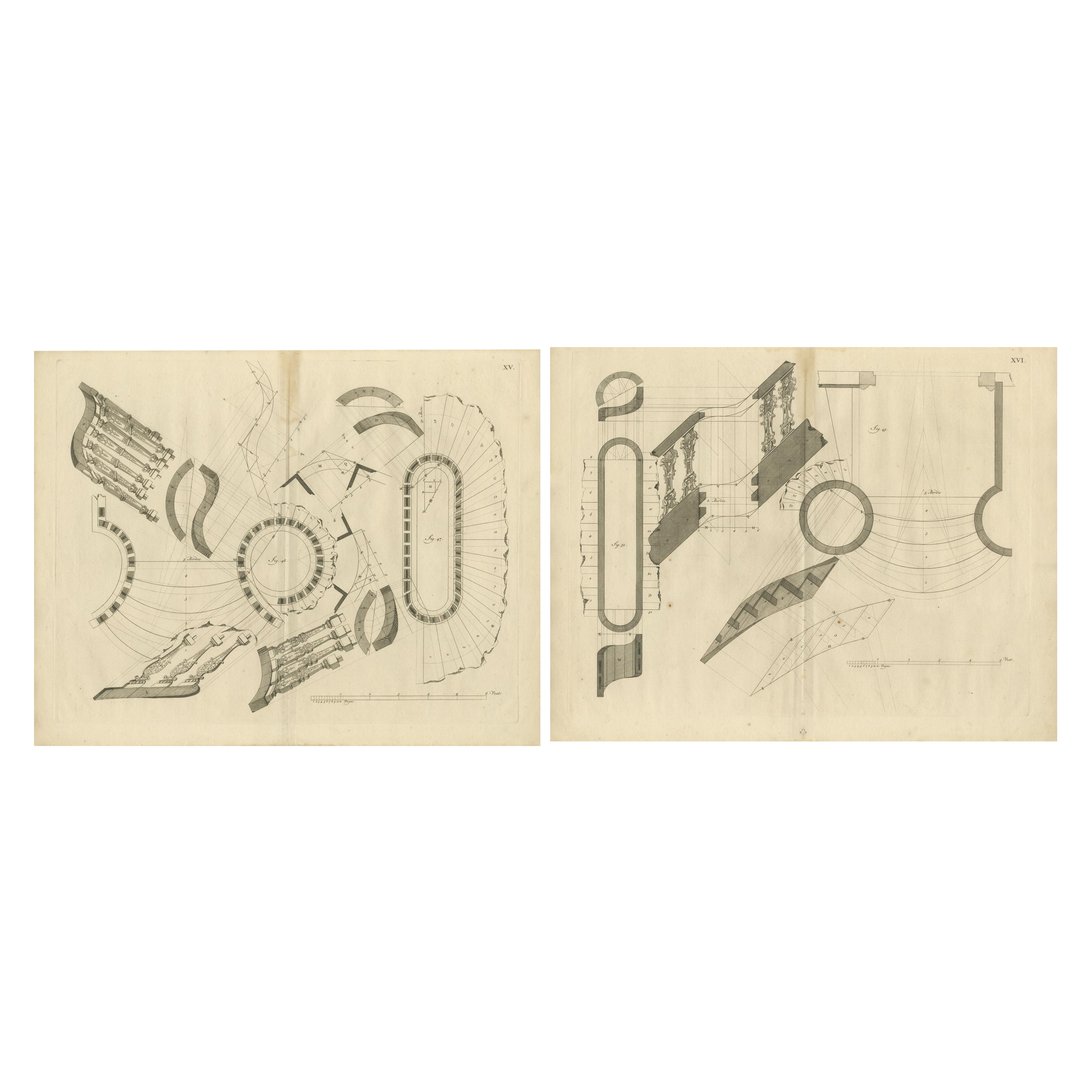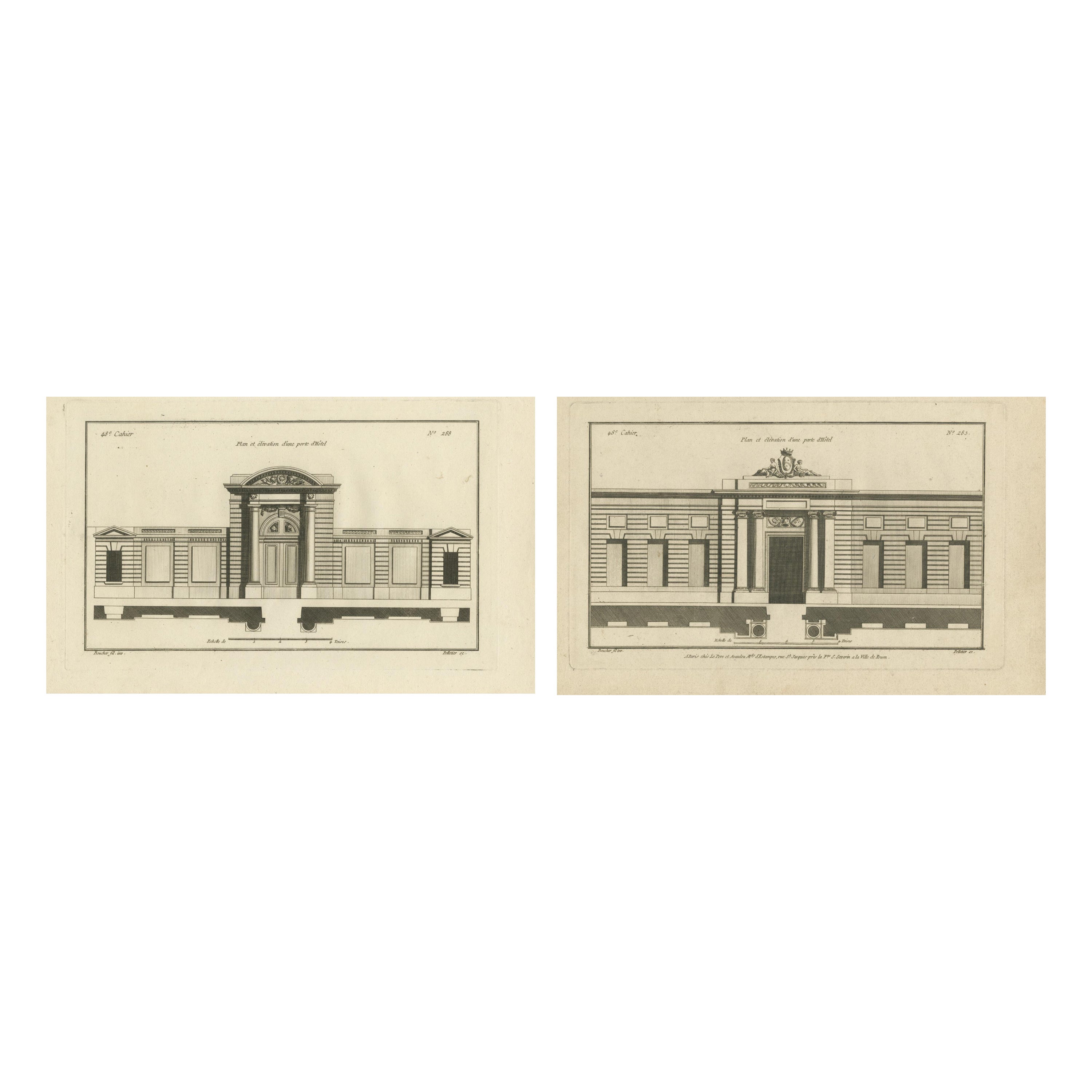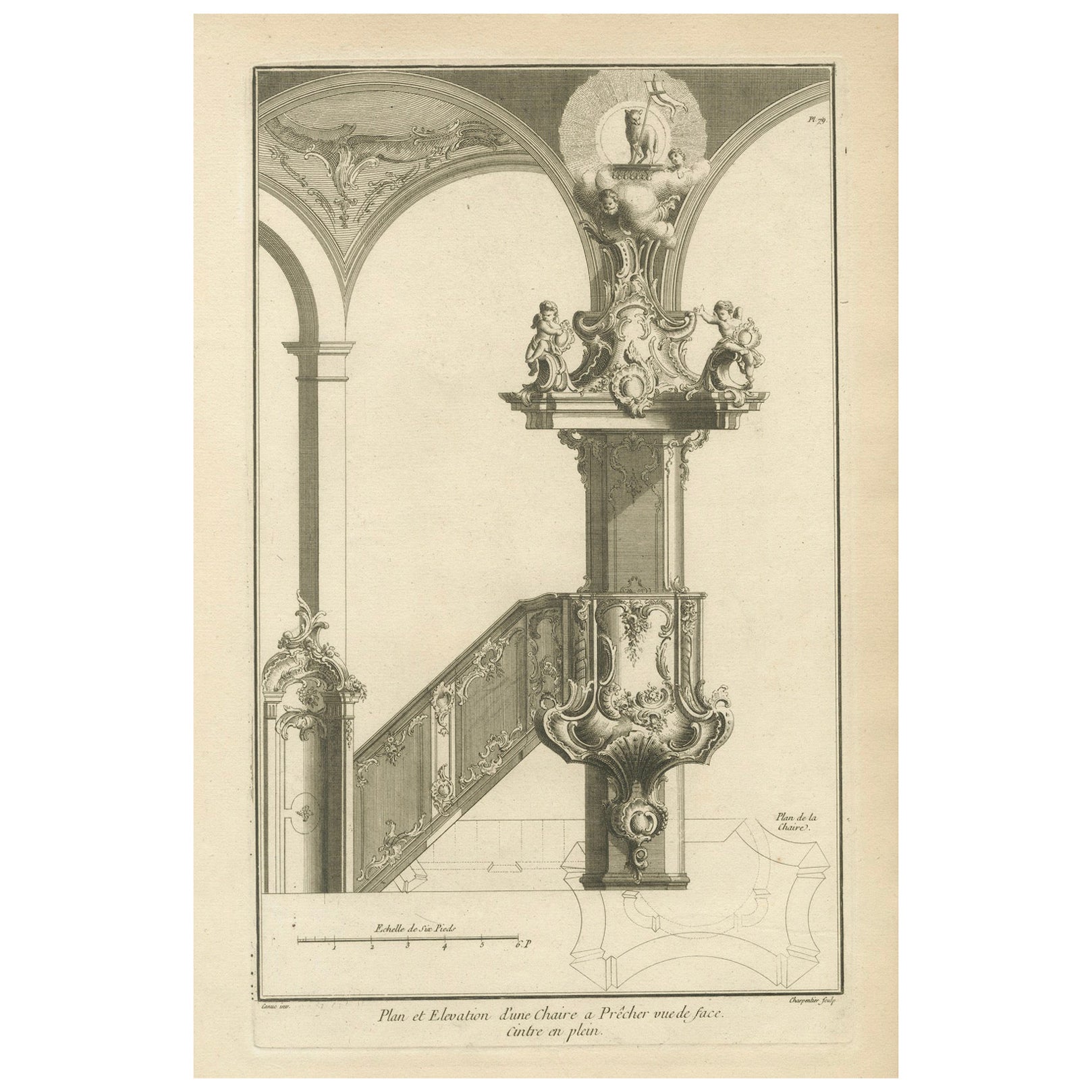Items Similar to Baroque Ironwork Designs: Tables and Candelabras Engraved, 1767
Want more images or videos?
Request additional images or videos from the seller
Baroque Ironwork Designs: Tables and Candelabras Engraved, 1767
About the Item
The engravings are a stunning representation of Baroque ironwork designs, a testament to the intricate artistry of the 18th century. Created in 1767, the works of Charpentier and Huquier, as well as Soubeyaran and Oppenort, are depicted in these images. They showcase an array of ornamental tables and candelabras, each piece rich with the elaborate detail characteristic of the Baroque era.
Tables are adorned with scrollwork, floral and foliage motifs, and classical figures, often with a central crest or medallion. These designs not only reflect the aesthetic of the time but also the technical skill involved in working iron into such delicate patterns.
The candelabras exhibit a similar level of ornamentation, with multiple arms gracefully curving outwards to hold candles, often topped with elaborate finials. These would have served as both functional items and decorative centerpieces, illuminating the lavish interiors of the period.
The fact that these designs have been preserved in such detailed engravings allows us to appreciate the beauty and complexity of Baroque decorative arts, especially in ironwork, which required a high level of craftsmanship and artistry to produce. The engravings serve as a historical record of the decorative trends and techniques of the time, and they continue to inspire admiration for the mastery of Baroque artisans.
More about the artists:
Étienne Charpentier (c. 1707–c. 1792) was a French artist known for his work in the Rococo style, which was prevalent during the 18th century. While specific details about his life may not be widely documented or readily available, we do know that artists of this era, especially those active in the decorative arts, were often involved in producing designs for a variety of luxury items and architectural elements that were in vogue among the European elite.
The Rococo style, where Charpentier's work would be categorized, emerged in France as a decorative evolution of the Baroque era, characterized by lighter themes, more playful and intricate ornamentation, and an emphasis on asymmetry and curved lines. This style was epitomized by elaborate scrollwork, floral patterns, and a general sense of elegance and fluidity.
Given the time frame in which Étienne Charpentier was active, it is likely that he contributed to the design of ornamental engravings, interior decorations, and possibly furniture or architectural detailing. Artists and designers of the Rococo period often created intricate engravings to be used by craftsmen in the manufacture of decorative items. These engravings served as templates for works in various mediums, including ironwork, woodwork, and textile production.
Charpentier, like his contemporaries, would have been part of a network of artists, engravers, and patrons who collaborated to produce works that reflected the tastes and styles of the period. His contributions would have been part of the larger cultural movement that spread across Europe, influencing art, architecture, and the decorative arts well into the late 18th century.
Huquier: Gabriel Huquier (1695–1772) was a French draftsman, engraver, and printmaker. He was known for his rocaille engravings and was part of the Rococo movement that was prevalent during the first half of the 18th century. Huquier was notable for his work in chinoiserie, a style that was characterized by the use of motifs and techniques that were thought to be Chinese.
Pierre Soubeyran was an artist and craftsman from Geneva, born on November 6, 1709, and lived until April 12, 1775. While specific information about Soubeyran's individual works and contributions to the art world might not be as widely known or documented as those of some of his contemporaries, we can infer from the period and region in which he lived certain aspects about the nature of his work.
Geneva, during the 18th century, was a hub for luxury goods and craftsmanship, particularly known for watchmaking and related fine metalwork. As an artist active in this milieu, Soubeyran might have been involved in the design and production of decorative art pieces, which would have included engraving, metalwork, and possibly horology, given the strong tradition of watchmaking in Geneva.
The Republic of Geneva was also a center of enlightenment thought during Soubeyran's lifetime. The city attracted intellectuals from all over Europe, and this environment could have influenced the local art scene, potentially including Soubeyran's work, fostering a culture of innovation and intricate design that would be reflected in the decorative arts.
Given the dates of his life, Soubeyran's career would have spanned the latter part of the Baroque period and into the Rococo, and he may have witnessed the beginning shifts towards Neoclassicism. His work would likely have been characterized by the ornate and intricate qualities typical of the time, with a potential emphasis on the precision and elegance demanded by Geneva's luxury goods market.
Gilles-Marie Oppenordt (also spelled Oppenord), born on July 27, 1672, and died on March 13, 1742, was a prominent French architect and ornamental designer, known for his significant role in the development and dissemination of the Rococo style in architecture and decorative arts. He is often considered one of the preeminent figures in introducing the Rococo to French decorative art.
Educated in Paris and Rome, Oppenordt was heavily influenced by the Baroque grandeur of Italian architecture. After his return to France, he became the court architect to Philippe II, Duke of Orléans, who was the regent for Louis XV of France. Under this patronage, Oppenordt's work flourished, and he was commissioned to carry out numerous grand projects.
Oppenordt's designs were characterized by their lightness, elegance, and fluidity, breaking away from the stricter, more geometric patterns of the earlier Baroque style. He was adept at integrating the traditional elements of French classicism with the playful and intricate motifs that came to define the Rococo.
Among his notable contributions are his designs for the Palais-Royal and the Hôtel de Pompadour in Paris. He was also responsible for creating many ornamental engravings and designs for furniture and other decorative objects, which were compiled in a book titled "Oeuvres d'architecture de Gilles-Marie Oppenordt." This book helped spread the Rococo style throughout France and beyond, influencing craftsmen and designers across Europe.
Oppenordt's legacy lies in his synthesis of Italian Baroque elements with French artistic traditions, which resulted in a unique and influential style that enriched the visual culture of the Rococo period.
- Dimensions:Height: 16.54 in (42 cm)Width: 10.52 in (26.7 cm)Depth: 0 in (0.02 mm)
- Sold As:Set of 4
- Materials and Techniques:Paper,Engraved
- Period:1760-1769
- Date of Manufacture:1767
- Condition:Condition: Good. General age related toning and occasional light staining from handling. Left margin with small holes from binding, outside the platemark. A brownish hue mainly outside the plate mark. Strong hand-pressed paper.
- Seller Location:Langweer, NL
- Reference Number:
About the Seller
5.0
Platinum Seller
These expertly vetted sellers are 1stDibs' most experienced sellers and are rated highest by our customers.
Established in 2009
1stDibs seller since 2017
1,950 sales on 1stDibs
Typical response time: <1 hour
- ShippingRetrieving quote...Ships From: Langweer, Netherlands
- Return PolicyA return for this item may be initiated within 14 days of delivery.
More From This SellerView All
- Neufforge's Engraved Gates Design: 18th-Century Designs, circa 1770Located in Langweer, NLThe prints by Neufforge depict designs for entrances. The French term "hôtel" in the 18th century referred not to a hotel as we understand it today (a place where travelers pay for l...Category
Antique Late 18th Century Prints
MaterialsPaper
- Baroque Pulpit Elevation with Ornate Archway and Balustrade Engraved, ca.1740Located in Langweer, NLThis is an original antique architectural design for a pulpit in baroque style with archway and balustrade dating approximately between 1740 and 1760. The artist responsible for th...Category
Antique 1740s Prints
MaterialsPaper
- Baroque Splendor: Van der Horst's Staircase Visions Engraved, 1739Located in Langweer, NLTitle: "Baroque Splendor: Van der Horst's Staircase Visions" Description: These engravings from "THEATRUM MACHINARUM UNIVERSALE" exemplify the grandeur and complexity of Baroque sta...Category
Antique 1730s Prints
MaterialsPaper
- Renaissance Architectural Orders by Vignola's Frontispiece, 1767Located in Langweer, NLThis image is an intricate frontispiece from a book by Jacques Barozzi de Vignole, known as Vignola, an influential 16th-century Italian architect who was one of the great architect ...Category
Antique 1850s Prints
MaterialsPaper
- Bougainville's Claim in the Magellan Straits, circa 1767Located in Langweer, NLThe engraving depicts the French explorer Louis Antoine de Bougainville hoisting the French colors upon a small rock in the Magellan Straits. This act symbolizes the claiming of terr...Category
Antique 1760s Prints
MaterialsPaper
- Antique Print of the City and Port of Valparaíso, Chile by Tirion '1767'By Isaak TirionLocated in Langweer, NLAntique print titled 'Gezigt van de Stad Valparayso in Chili'. Detailed view of the city and port of Valparaíso, Chile. With Dutch key. As indicated by the presence of the fort and b...Category
Antique Mid-18th Century Prints
MaterialsPaper
You May Also Like
- View of the Palazzo Pamphili and Piazza Navona in Rome by Le Geuy, 1767Located in Kenilworth, ILEngraving on laid paper of the Piazza Navona in Rome. The view is expansive, with the Fontana del Moro in the foreground, the Fiumi Fountain in the center of the piazza, and the dome...Category
Antique 1760s British Prints
MaterialsPaper
- Frank Lloyd Wright Buildings Plans and Designs - Large Plate LithographsBy Frank Lloyd Wright FoundationLocated in Espoo, FIThis is an enormous booklet (25.75 X 16 Inches): Frank Lloyd wright buildings, plans and designs. 96 Large scale plate drawings and plans on quality wove paper by Frank Lloyd Wright,...Category
Vintage 1960s American Prints
MaterialsPaper
- Old Framed Map of a Plan of the City of New York as Surveyed in 1767Located in Lambertville, NJOld framed map of a plan of the City of New York as surveyed in 1767. Published by the Common Council and lithographed by George Hayward circa 1800. Repro...Category
Antique Late 19th Century American Prints
MaterialsWood, Paper
- 'the Sopranos' Set Designs by Dean TaucherBy Dean TaucherLocated in NYC, NYCollection of set designs for the HBO original series. The Sopranos, some signed by Dean Taucher, several with notes in the margin. A fascinating glimpse ...Category
Late 20th Century American Prints
- Framed Early 19th Century Drawn and Engraved Map of ChinaBy John Knighton ThomsonLocated in San Francisco, CAHand drawn and tinted engraved map of China dated 1815 Created for Thomson's New General Atlas Edinburgh Beautifully framed with a linen covered mat.Category
Antique Early 19th Century European Prints
MaterialsPaper
- Original Antique Map of Spain and Portugal, Engraved By Barlow, 1806Located in St Annes, LancashireGreat map of Spain And Portugal Copper-plate engraving by Barlow Published by Brightly & Kinnersly, Bungay, Suffolk. 1806 Unframed.Category
Antique Early 1800s English Maps
MaterialsPaper





